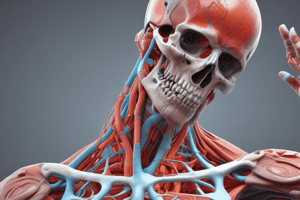Podcast
Questions and Answers
A gymnast performing a cartwheel is primarily utilizing which type of movement?
A gymnast performing a cartwheel is primarily utilizing which type of movement?
- Abduction and adduction in combination.
- Hyperextension to achieve maximum joint angle.
- Circumduction, involving flexion, extension, abduction, and adduction. (correct)
- Rotation along a longitudinal axis.
Which scenario exemplifies eversion of the foot?
Which scenario exemplifies eversion of the foot?
- Standing with the weight primarily on the inner edge of the foot.
- Pointing the toes downwards while standing.
- Lifting the foot off the ground.
- Turning the sole of the foot laterally. (correct)
A person is performing a 'jumping jack' exercise. What combination of movements are primarily involved when the arms are moved away from and then back towards the midline of the body?
A person is performing a 'jumping jack' exercise. What combination of movements are primarily involved when the arms are moved away from and then back towards the midline of the body?
- Abduction and Adduction (correct)
- Pronation and Supination
- Flexion and Extension
- Inversion and Eversion
A dancer is performing a routine that involves moving across the stage in a series of steps where one foot steps forward and the other 'cuts' behind it. Which type of locomotor movement is the dancer primarily using?
A dancer is performing a routine that involves moving across the stage in a series of steps where one foot steps forward and the other 'cuts' behind it. Which type of locomotor movement is the dancer primarily using?
A weightlifter is performing a bicep curl. At the bottom of the movement, with their arm fully extended, what anatomical movement is occurring at the elbow joint as they begin to lift the weight towards their shoulder?
A weightlifter is performing a bicep curl. At the bottom of the movement, with their arm fully extended, what anatomical movement is occurring at the elbow joint as they begin to lift the weight towards their shoulder?
Flashcards
Flexion
Flexion
Decreases the angle of a joint.
Extension
Extension
Increases the angle between two bones.
Abduction
Abduction
Movement away from the midline of the body.
Adduction
Adduction
Signup and view all the flashcards
Inversion
Inversion
Signup and view all the flashcards
Study Notes
Types of Ordinary Body Movements
- Flexion decreases the angle of the joint.
- Extension increases the angle between two bones.
- Hyperextension occurs when the angle is 180 degrees.
- Rotation happens along a longitudinal axis.
- Abduction moves away from the midline.
- Adduction moves toward the midline.
- Circumduction combines flexion, extension, adduction, and abduction, common in ball and socket joints.
Types of Special Movements
- Inversion turns the foot medially.
- Eversion turns the foot laterally.
- Supination turns the palm or face upward.
- Pronation turns the palm or face downward.
- Opposition touches the tips of other fingers on the same hand.
Two Forms of Movement
- Locomotor movements involve moving from one place to another.
- Walking is shifting one's weight from one foot to the other.
- Running involves longer strides.
- Hopping is springing on one foot and landing on the same foot.
- Skipping is a hop using the same foot.
- Jumping involves landing on both feet.
- Leaping involves springing on one foot and landing on the other foot.
- Sliding moves sideward or forward using the right and left foot.
- Galloping is stepping on one foot and cutting the other.
Studying That Suits You
Use AI to generate personalized quizzes and flashcards to suit your learning preferences.




